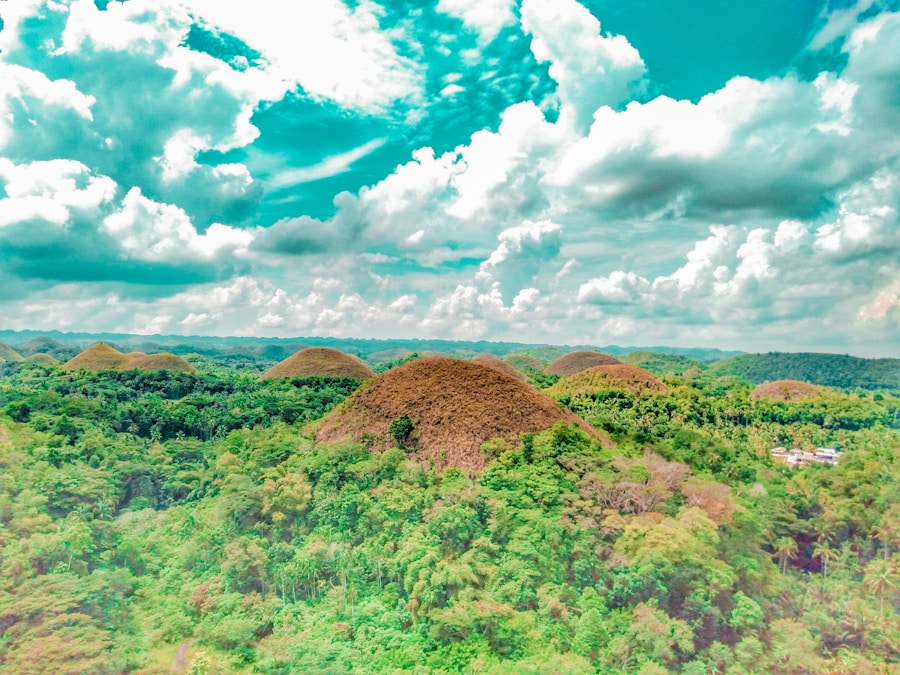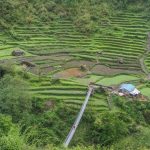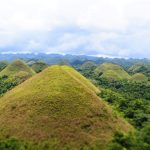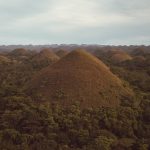Download links
How to install Discovering the Mysterious Chocolate Hills APK?
1. Tap the downloaded Discovering the Mysterious Chocolate Hills APK file.
2. Touch install.
3. Follow the steps on the screen.
Description
The Chocolate Hills, a geological wonder located in the heart of Bohol, Philippines, are steeped in local folklore and legend. One of the most popular tales recounts the story of two giants, Arogo and Aluya, who fell in love with a beautiful mortal woman. Their rivalry over her affection led to a fierce battle that caused great destruction across the land.
In their grief over the loss of their beloved, the giants wept for days, and their tears eventually transformed into the rolling hills that we see today. This poignant narrative not only explains the hills’ unique shape but also reflects the deep emotional connection that the local people have with their natural surroundings. Another legend tells of a giant named Arogo who was known for his strength and beauty.
He fell in love with a mortal woman, but she passed away, leaving him heartbroken. In his sorrow, Arogo wept uncontrollably, and his tears formed the hills that now dot the landscape. This tale emphasizes themes of love and loss, illustrating how nature can be intertwined with human emotions.
The Chocolate Hills have thus become more than just a geological formation; they are a symbol of love, loss, and the enduring power of nature’s beauty.
Key Takeaways
- The Chocolate Hills in the Philippines are a natural wonder and a legendary attraction.
- The unique geological formation of the Chocolate Hills is a result of limestone weathering and erosion.
- The flora and fauna of the Chocolate Hills include a variety of plant and animal species, some of which are endemic to the area.
- The best ways to experience the Chocolate Hills include hiking, biking, and taking in the panoramic views from viewing decks.
- Conservation efforts are in place to preserve the natural beauty and ecological significance of the Chocolate Hills.
- The Chocolate Hills hold cultural significance for the Filipino people and are a source of pride and inspiration.
The Geological Formation of the Chocolate Hills
The Chocolate Hills are an extraordinary geological formation consisting of approximately 1,268 to 1,776 symmetrical hills that rise dramatically from the surrounding flatlands. These hills are primarily composed of limestone, which has undergone extensive erosion over thousands of years. The process began when the area was submerged underwater, allowing marine organisms to deposit calcium carbonate on the seabed.
Over time, tectonic activity lifted this limestone above sea level, where it was exposed to the elements.
Rainwater, combined with the region’s tropical climate, has gradually worn away the softer materials surrounding the limestone, leaving behind these distinct conical shapes.
The hills are particularly striking during the dry season when the grass covering them turns brown, resembling chocolate mounds—hence their name. This unique geological process not only creates a stunning visual spectacle but also provides insight into the Earth’s geological history and the forces that shape our planet.
Exploring the Flora and Fauna of the Chocolate Hills

The Chocolate Hills are not just a feast for the eyes; they also host a diverse array of flora and fauna that thrive in this unique environment. The hills are primarily covered with grass, which turns brown during the dry season but bursts into vibrant green during the rainy months. This seasonal transformation supports various species of plants and animals that have adapted to the changing conditions.
Among these are endemic species such as the Philippine tarsier, one of the world’s smallest primates, which can be found in the nearby forests. Birdwatchers will find delight in observing numerous avian species that inhabit the area. The hills provide a habitat for various birds, including the Philippine eagle and several species of kingfishers.
The unique topography of the Chocolate Hills creates microhabitats that support different ecological niches, allowing for a rich biodiversity that is both fascinating and essential for maintaining ecological balance. The interplay between flora and fauna in this region highlights the importance of preserving such unique ecosystems for future generations. For more information on the biodiversity of the Chocolate Hills, you can visit the International Union for Conservation of Nature (IUCN) website.
The Best Ways to Experience the Chocolate Hills
| Experience | Details |
|---|---|
| Viewing Points | There are multiple viewing points to see the Chocolate Hills, including the Chocolate Hills Complex, Sagbayan Peak, and the town of Carmen. |
| ATV Adventure | Visitors can explore the Chocolate Hills on an ATV adventure, riding through the unique landscape and enjoying the panoramic views. |
| Trekking | There are trekking trails around the Chocolate Hills, allowing visitors to hike and explore the natural beauty of the area. |
| Zip Lining | For an adrenaline rush, visitors can experience zip lining over the Chocolate Hills, providing a thrilling perspective of the landscape. |
| Cultural Immersion | Visitors can also engage with the local community and learn about the culture and traditions of the people living near the Chocolate Hills. |
Visiting the Chocolate Hills offers numerous opportunities for exploration and adventure. One of the most popular ways to experience this natural wonder is by hiking to one of the viewing platforms that provide panoramic views of the landscape. The most famous viewpoint is located at Chocolate Hills Complex in Carmen, where visitors can climb a series of stairs to reach an observation deck that overlooks hundreds of hills stretching into the horizon.
This vantage point allows for breathtaking photographs and a chance to appreciate the sheer scale of this geological marvel. For those seeking a more immersive experience, biking or ATV tours through the surrounding countryside offer an exhilarating way to explore the area. These tours often take visitors off the beaten path, allowing them to discover hidden gems such as local villages and lesser-known viewpoints.
Additionally, guided tours can provide valuable insights into the history and geology of the Chocolate Hills, enriching visitors’ understanding of this unique landscape. Whether through hiking, biking, or simply enjoying a leisurely stroll among the hills, there are countless ways to connect with this extraordinary natural site.
Conservation Efforts to Preserve the Chocolate Hills
As a UNESCO World Heritage Site and one of the Philippines’ most iconic landmarks, conservation efforts are crucial to preserving the integrity of the Chocolate Hills. Local government units and environmental organizations have implemented various initiatives aimed at protecting this unique ecosystem from threats such as deforestation, pollution, and unsustainable tourism practices. These efforts include reforestation projects that aim to restore native vegetation around the hills and promote biodiversity.
Education plays a vital role in conservation efforts as well. Local communities are engaged in awareness campaigns that highlight the importance of preserving their natural heritage. By fostering a sense of stewardship among residents and visitors alike, these initiatives encourage sustainable practices that benefit both people and nature.
Additionally, regulations have been put in place to manage tourist activities effectively, ensuring that visitors can enjoy the beauty of the Chocolate Hills while minimizing their impact on this fragile environment.
The Cultural Significance of the Chocolate Hills

Beyond their geological and ecological importance, the Chocolate Hills hold significant cultural value for the people of Bohol. They are often featured in local folklore and art, symbolizing not only natural beauty but also resilience and identity for Boholanos. The hills serve as a backdrop for various cultural events and festivals, where locals celebrate their heritage through music, dance, and traditional crafts.
This connection between culture and landscape fosters a sense of pride among residents and reinforces their commitment to preserving this iconic site. Moreover, the Chocolate Hills have become an integral part of Bohol’s tourism industry, attracting visitors from around the globe who come to marvel at their beauty. This influx of tourists has provided economic opportunities for local communities while also emphasizing the need for responsible tourism practices that respect both cultural traditions and environmental sustainability.
As such, the Chocolate Hills stand as a testament to how natural wonders can shape cultural identity while simultaneously providing avenues for economic growth and community development.
FAQs
What are the Chocolate Hills?
The Chocolate Hills are a geological formation located in the Bohol province of the Philippines. They are made up of around 1,200 to 1,776 conical limestone hills, which are covered in green grass that turns brown during the dry season, giving them a chocolate-like appearance.
How were the Chocolate Hills formed?
The exact formation process of the Chocolate Hills is still a subject of debate among geologists. However, it is widely believed that they are the result of the uplift of coral deposits and the action of rainwater and erosion over millions of years.
What is the significance of the Chocolate Hills?
The Chocolate Hills are a major tourist attraction in the Philippines and are considered a natural wonder. They have been declared the country’s third National Geological Monument and are included in the Tentative List for UNESCO World Heritage Sites.
Can visitors explore the Chocolate Hills?
Yes, visitors can explore the Chocolate Hills by climbing the viewing deck in the town of Carmen, which offers panoramic views of the hills. There are also hiking trails and ATV tours available for those who want to explore the area more closely.
Are there any legends or myths associated with the Chocolate Hills?
One popular legend about the formation of the Chocolate Hills involves two giants who were throwing rocks and sand at each other in a fit of rage, and when they reconciled, they left behind the hills. This legend is a part of the local folklore and adds to the mystique of the Chocolate Hills.





